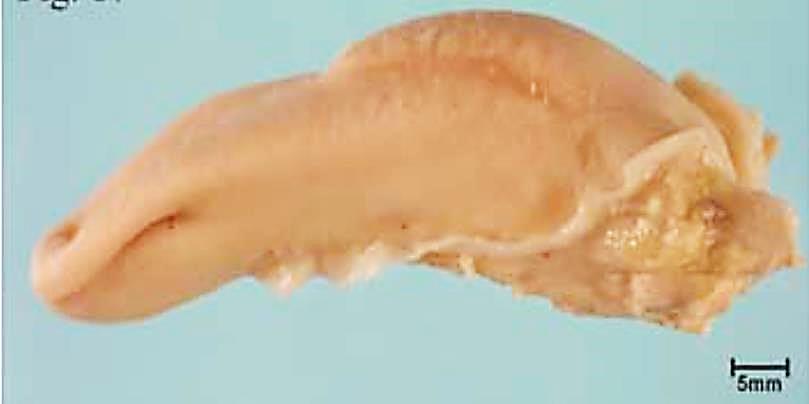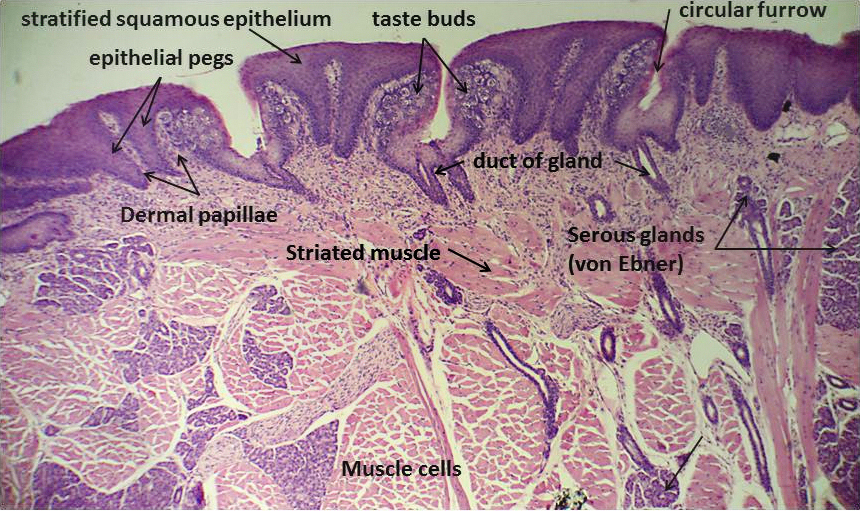Anatomy of the tongue in rabbits
Esther van Praag, Ph.D.
|
MediRabbit.com is
funded solely by the generosity of donors. Every
donation, no matter what the size, is appreciated and will aid in the
continuing research of medical care and health of rabbits. Thank you |
Warning: this file contains pictures
that may be distressing to some persons
|
As in other mammals, the hyoid bon anchors the
rabbit tongue into the floor of the mouth. From here the long narrow tongue
projects upwards and to the front. At the age of 6 months, the total length
of the tongue reaches 65 mm in length, with the apex and the body measuring
16 and 37 mm, respectively. The width of the tongue averages between 15 and
17 mm according to the region. The protuberance of the posterior part of the
tongue (torus linguae) is fully developed. The median sulcus, which
divides the tongue into symmetrical halves, extends from the apex to the body
of the tongue and ends in front of the torus. On the ventral side of the
tongue, a medial membrane (frenulum linguae) attaches the middle line
of the tongue to the floor of the mouth, limiting the movement of the latter.
Extrinsic muscles restrict the movement of the tongue and give it its
characteristic convex form; they include the hyoglossus
depressor muscle, the basioglossis muscle, the ceratoglossus muscle and the chondroglossus
muscle, as well as the genioglossus and the styloglossus
muscles. The shape of the tongue is very flexible and changes
during mastication and pushing of the ingesta to
the back of the oral cavity, thanks to a series of intrinsic muscles (lingualis proprius)
in its body: -
in the dorsal part: longitudinal
and superficial muscle fibers; -
In the central part: perpendicular
and transverse muscle fibers, - In the
ventral part: longitudinal and deep muscle fibers.
As observed
by Cortopassi and Muhl
(1990) during videofluorographic studies of the
tongue during mastication: In the lateral view the forepart of the tongue
moves down and forward during the opening stroke, whereas the intermolar eminence moves up and forward to appose the palate. During the closing stroke, as the tip
of the tongue moves up and back, the intermolar
eminence lowers from the palate and retracts. During the power stroke the
forepart of the tongue is at its most elevated and retruded
position, while the intermolar eminence is its
lowest and most retruded. The dorso-ventral
view showed that lateral movement of the tongue and mandible are highly
synchronous. The intermolar eminence decreases in
width during the power stroke, possibly twisting to place or keep food on the
teeth. An anterior to posterior undulating movement of the entire tongue
occurs throughout the chewing cycle. As the intermolar
eminence elevates to appose the palate during the
opening stroke, it may replace the bolus on the teeth on the chewing side.
The intermolar eminence also appears to be twisting
during the closing and power strokes to place or maintain food on the teeth.
This allows that the ingested food is pushed backwards from the front-diastemal region to the cheek teeth (premolars and
molars) where food is placed on the mandibular cheek teeth, to get chewed in
small pieces. From here, the ingesta is pushed to the posterior region of the oral cavity. The
combined action of the tongue, the soft palate and the pharynx muscles allow
swallowing.
The dorsal part
of the tongue is divided in posterior smooth and hard portions, and anterior
smooth and rough portions. All possess extensions in the mucus membrane that
form the taste buds. According to the location on the tongue, different types
of papillae are present: - Filiform
papillae the numerous elongated conical papillae are observed on the dorsal
softer anterior end of the tongue. - Fungiform
papillae mushroom shaped projection found along the rostral margin of the
tongue. They contain taste buds. - Vallate papillae two dome shaped
papillae are set symmetrically in the mucus membrane of the apex and the body
of the tongue and on the side of the torus. Vallate
papillae may contain taste buds and lymph nodes. - Foliata papillae these are well
developed in Lagomorphs and domestic rabbits. They are located in about 20
ridges on the posterior lateral sides of the tongue. Numerous taste buds - up
to 7440 buds according to Engelman (1872) are
found in the circular furrows, lining the walls of the papillae. There pores
open in the cleft. The taste buds are connected to sensory nerve fibers
that carry the provided information to the brain. Further
Information Cortopassi D, Muhl
ZF. Videofluorographic analysis of tongue movement
in the rabbit (Oryctolagus cuniculus). J Morphol.
1990 May;204(2):139-46. Engelmann Th.W. The Organs of Taste. Strieker's
Manual of Histology,' New York, 1872. Kulawik M, Godynicki
S. Fungiform papillae of the tongue in the rabbit (Oryctolagus cuniculus).
Pol J Vet Sci. 2007a;10(1):25-7. Kulawik M, Godynicki
S. Vallate papillae in the domestic rabbit (Oryctolagus
cuniculus f. domestica). Pol J Vet Sci. 2007b;10(1):47-50. Kulawik M, Szymon
Godynicki S. Development of the tongue in the
rabbit (Oryctolagus cuniculus f. domestica)
and the order of formation of lingual papillae in pre- and postnatal life 1. Acta Sci. Pol., Medicina Veterinaria 8(4) 2009, 15-26. Ojima, K.; Hosaka,
M. & Suzuki, Y. Functional and positional difference and classification
of the fungiform papillae on the rabbit tongue seen in microvascular cast
specimens by means of scanning electron microscope. Ann. Anat., 182(6):521-4,2000. Nonaka, K.; Zheng, J. H. &
Kobayashi, K. Comparative morphological study on the lingual papillae and
their connective tissue cores in rabbits. Okajimas
Folia Anat. Jpn., 85(2):57-66,2008. |






